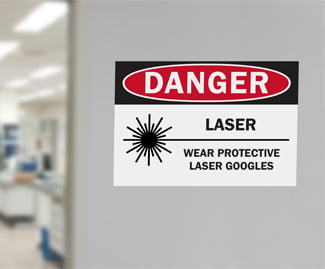New Safety Controls Expand As Industrial Laser Use Grows

After years of precursory work by engineers and scientists, in 1960, an American physicist was able to generate an intense, very narrow beam of light of a single wavelength. Since then, fascinations, imaginations, and new discoveries using Light Amplification by Stimulated Emission of Radiation, or laser technology, have spiraled. The industrial laser market in 2017 grew by 26% with a more modest growth expected for 2018 driven by developments in fine metal, non-metal, and additive manufacturing, according to a report by David Belforte, chief editor of Industrial Laser Solutions.
Laser Use Increasing
 Industrial interest in lasers has grown, propelling developments in additive manufacturing, also known as 3D printing. In additive manufacturing, components are created from nothing more than powder and laser light. Industries that are practicing this type of manufacturing include aerospace, automotive, medical, dental, sciences, and retail. Some of the uses include cutting, welding, surveying, marking, and cladding. Within the medical sector, custom models and parts are cost-effective to build without sacrificing strength. Recently, 3D printing has found applications in dentistry to create crowns and bridges, and it is moving toward the ability to create permanent restorations in dental composites.
Industrial interest in lasers has grown, propelling developments in additive manufacturing, also known as 3D printing. In additive manufacturing, components are created from nothing more than powder and laser light. Industries that are practicing this type of manufacturing include aerospace, automotive, medical, dental, sciences, and retail. Some of the uses include cutting, welding, surveying, marking, and cladding. Within the medical sector, custom models and parts are cost-effective to build without sacrificing strength. Recently, 3D printing has found applications in dentistry to create crowns and bridges, and it is moving toward the ability to create permanent restorations in dental composites.
The paradigm shift toward additive manufacturing carries the promise of producing complex objects without using any tools. Steady progress is being made, albeit slowly. It is very suitable for a manufacturing environment where products assembled vary in application, lot size, and production processes, said Anand Prakasam, head of EOS India. However, Gordon Styles, president and founder of Star Rapid, says lack of design for manufacturing knowledge is delaying full-on adoption of this technology for additive manufacturing. Learning takes time and mastering takes experience. Another hold up, he said, is that 3D printing technology is slow and expensive. "Despite it being years away from true commercial viability, it can certainly find niche applications right now," he said.
Laser Safety Controls
According to the U.S. Department of Energy Berkeley Lab, the chief concern over laser use is the possibility of eye and skin injuries. Eye injuries drive the need for workplace laser safety, funding, controls, and application. Biological effects from direct exposure and diffuse reflection exposure will differ. The American National Standards Institute has compliance standards for laser safety in the United States: ANSI Z136. Here are several tips to communicate laser hazards and safety in additive manufacturing:
- Communicate laser classification, laser parameters, and optical density requirements for laser eye wear on laser hazard warning signs
- Post signs/procedures (or equivalent) near the laser control panel to communicate changing operation modes
- Post emergency entry procedures, including a description of how the laser hazard is disabled, near the control area entry
- Post a visitor policy near the laser working area
- Display a core laser safety practices poster
- Label emergency off buttons
Lasers are used in industry for a variety of applications. As this technology develops, so must workplace safety plans. Materials processing with high-powered lasers can include cutting, drilling, and welding, which harbor potential hazards. Warn of the dangers and display precautions associated with lasers using custom or premade laser safety signs and labels. Communicate and highlight the importance of wearing proper personal protective equipment where a laser is present, for dust particle protection, vision and skin protection, and more. Duralabel is an innovative global leader in industrial label and sign printers, providing compliance and educational resources to protect workers. Produce OSHA/ANSI compliant labels with an industrial label and sign printing system, such as the versatile and easy-to-use DuraLabel Toro Max. For more information about products and services, call 888-965-3359.
Related Resources

Industrial Safety Labels | Label Signage | Sign Label
The accurate interpretation of safety signs is crucial to prevent injuries and save lives. OSHA has set ...
Read
Redefining Job Site Safety Through Better Custom Labeling
How Do Contractors Use Labels and Signs for Better Job Site Safety? The final steps of a project are just as ...
Read
Find the Right Field Printer for On-Site Safety and Compliance
Why Do You Need a Field Printer for On-Site Projects? A field printer is essential because it allows crews to ...
Read.png)





